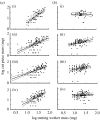Geometry explains the benefits of division of labour in a leafcutter ant
- PMID: 18319212
- PMCID: PMC2602677
- DOI: 10.1098/rspb.2008.0024
Geometry explains the benefits of division of labour in a leafcutter ant
Abstract
Many ant species have morphologically distinct worker sub-castes. This presumably increases colony efficiency and is thought to be optimized by natural selection. Optimality arguments are, however, often lacking in detail. In ants, the benefits of having workers in a range of sizes have rarely been explained mechanistically. In Atta leafcutter ants, large workers specialize in defence and also cut fruit. Fruit is soft and can be cut by smaller workers. Why, therefore, are large workers involved? According to the geometry hypothesis, cutting large pieces from three-dimensional objects like fruit is enhanced by longer mandibles. By contrast, long mandibles are not needed to cut leaves that are effectively two-dimensional. Our results from Atta laevigata support three predictions from the geometry hypothesis. First, larger workers cut larger fruit pieces. Second, the effect of large size is greater in cutting fruit than leaves. Third, the size of fruit pieces cut increases approximately in proportion to the cube of mandible length. Our results are a novel mechanistic example of how size variation among worker ants enhances division of labour.
Figures




Similar articles
-
Genetic caste polymorphism and the evolution of polyandry in Atta leaf-cutting ants.Naturwissenschaften. 2011 Aug;98(8):643-9. doi: 10.1007/s00114-011-0810-3. Epub 2011 Jun 8. Naturwissenschaften. 2011. PMID: 21656003
-
Specialization and group size: brain and behavioural correlates of colony size in ants lacking morphological castes.Proc Biol Sci. 2015 Feb 22;282(1801):20142502. doi: 10.1098/rspb.2014.2502. Proc Biol Sci. 2015. PMID: 25567649 Free PMC article.
-
Carriers and cutters: size-dependent caste polyethism in the tropical fire ant (Solenopsis geminata).Bull Entomol Res. 2020 Jun;110(3):388-396. doi: 10.1017/S0007485319000750. Epub 2019 Nov 18. Bull Entomol Res. 2020. PMID: 31735176
-
Individual versus social complexity, with particular reference to ant colonies.Biol Rev Camb Philos Soc. 2001 May;76(2):211-37. doi: 10.1017/s1464793101005656. Biol Rev Camb Philos Soc. 2001. PMID: 11396847 Review.
-
Battles between ants (Hymenoptera: Formicidae): a review.J Insect Sci. 2024 May 1;24(3):25. doi: 10.1093/jisesa/ieae064. J Insect Sci. 2024. PMID: 38913609 Free PMC article. Review.
Cited by
-
An evolutionary ecology of individual differences.Ecol Lett. 2012 Oct;15(10):1189-98. doi: 10.1111/j.1461-0248.2012.01846.x. Epub 2012 Aug 16. Ecol Lett. 2012. PMID: 22897772 Free PMC article.
-
Spatiotemporal resource distribution and foraging strategies of ants (Hymenoptera: Formicidae).Myrmecol News. 2014;20:53-70. Myrmecol News. 2014. PMID: 25525497 Free PMC article.
-
Mandible elemental composition and mechanical properties from distinct castes of the leafcutter ant Atta laevigata (Attini; Formicidae).Interface Focus. 2024 Apr 12;14(2):20230048. doi: 10.1098/rsfs.2023.0048. eCollection 2024 Apr 15. Interface Focus. 2024. PMID: 38618230 Free PMC article.
-
Morphological determinants of bite force capacity in insects: a biomechanical analysis of polymorphic leaf-cutter ants.J R Soc Interface. 2021 Sep;18(182):20210424. doi: 10.1098/rsif.2021.0424. Epub 2021 Sep 8. J R Soc Interface. 2021. PMID: 34493090 Free PMC article.
-
Quality versus quantity: Foraging decisions in the honeybee (Apis mellifera scutellata) feeding on wildflower nectar and fruit juice.Ecol Evol. 2016 Sep 20;6(19):7156-7165. doi: 10.1002/ece3.2478. eCollection 2016 Oct. Ecol Evol. 2016. PMID: 28725389 Free PMC article.
References
-
- Alcock J. 8th edn. Sinauer Associates; Sunderland, MA: 2005. Animal behavior: an evolutionary approach.
-
- Boomsma J.J, Nielsen J, Sundström L, Oldham N.J, Petersen H.C, Morgan E.D. Informational constraints on optimal sex allocation in ants. Proc. Natl Acad. Sci. USA. 2003;100:8799–8804. doi:10.1073/pnas.1430283100 - DOI - PMC - PubMed
-
- Burd M. Variable load size–ant size matching in leaf-cutting ants, Atta colombica, (Hymenoptera: Formicidae) J. Insect Behav. 1995;8:715–722. doi:10.1007/BF01997240 - DOI
-
- Burd M. Body size effects on locomotion and load carriage in the highly polymorphic leaf-cutting ants Atta colombica and Atta cephalotes. Behav. Ecol. 2000;11:125–131. doi:10.1093/beheco/11.2.125 - DOI
-
- Evison S, Ratnieks F.L.W. New role for majors in Atta leafcutter ants. Ecol. Entomol. 2007;32:451–454. doi:10.1111/j.1365-2311.2007.00877.x - DOI
Publication types
MeSH terms
LinkOut - more resources
Full Text Sources

